Chapter 6 of the Missouri Master Gardener Core Manual
Missouri is home to almost all temperate zone fruit plants, including strawberries, raspberries, blackberries, gooseberries, currants, blueberries, grapes, apricots, cherries, plums, nectarines, peaches, apples and pears. They can be harvested from mid-May through the end of October (Figure 1). However, because of differences in their requirements of weather and soil and in their susceptibility to pests, some fruit plants grow better than others. Raspberry plants favor cool summer and fall temperatures, so plants grown in Missouri are often stunted and produce small fruit. Raspberries also require a well-drained soil to prevent root diseases and therefore do not grow well in clay soils. Blackberries, grapes and many of the tree fruits are susceptible to spring frosts. Blueberries require a low soil pH (4.8 to 5.2) and high organic matter, so soil amendments are often added before planting. Because of these special requirements, a soil test is always recommended before planting, and care should be taken to place all fruit plants in sites with full sun. Low-lying areas should be avoided because cold air accumulates there, increasing the likelihood of spring frost damage and subsequent fruit loss. In spite of these challenges, harvesting fruit from your own property can be fun and rewarding. Table 1 shows how much fruit can be harvested per plant under typical Missouri conditions.
Table 1. Bearing age, planting longevity and estimated annual yield of fruit crops in Missouri.
| Fruit crop | Interval from planting to fruiting (years) | Life of plants (years) | Estimated annual yield per plant or row |
|---|---|---|---|
| Apple (standard) | 5 to 7 | 35 to 45 | 10 to 15 bu/tree |
| Apple (semidwarf) | 5 | 20 to 30 | 6 to 10 bu/tree |
| Apple (dwarf) | 3 | 15 to 20 | 3 to 6 bu/tree |
| Pear | 5 to 8 | 35 to 45 | 3 to 5 bu/tree |
| Peach | 2 to 4 | 10 to 15 | 3 to 6 bu/tree |
| Plum | 4 to 6 | 15 to 20 | 3 to 5 bu/tree |
| Tart cherry | 3 to 5 | 15 to 20 | 60 to 80 qt/tree |
| Grape | 3 | 20 to 30 | 50 to 100 qt/100 ft row |
| Strawberry (June-bearing) | 1 | 4 to 5 | 50 to 100 qt/100 ft row |
| Strawberry (everbearing) | 3 to 4 months | 2 | 50 qt/100 plants |
| Strawberry (day-neutral) | 2 to 3 months | 2 | 45 to 90 qt/100 plants |
| Raspberry (fall-bearing red) | 5 to 6 months | 5 to 12 | 100 to 150 pt/100 ft row |
| Raspberry (summer red) | 1 | 5 to 12 | 150 pt/100 ft row |
| Raspberry (black) | 1 | 5 to 12 | 1 qt |
| Raspberry (purple) | 1 | 5 to 12 | 1-1/2 qt |
| Blackberry (erect) | 1 | 5 to 12 | 40 qt/100 ft row |
| Blackberry (semierect) | 1 | 8 to 10 | 4 to 10 qt/100 ft row |
| Blueberry | 2 to 3 | 20 to 30 | 4 to 8 qt/plant |
| Fruit crop | May | June | July | August | September | October | |||||||
|---|---|---|---|---|---|---|---|---|---|---|---|---|---|
| Black raspberry | X | X | X | ||||||||||
| Fall-bearing red raspberry | X | X | X | X | X | X | X | ||||||
| Blackberry | X | X | X | X | X | X | X | X | X | X | X | ||
| Grape | X | X | X | ||||||||||
| Strawberry (June-bearing, day-neutral, everbearing) | X | X | X | X | X | X | X | X | X | X | |||
| Blueberry | X | X | X | ||||||||||
| Plum | X | X | |||||||||||
| Red raspberry | X | X | X | ||||||||||
| Peach | X | X | X | X | X | ||||||||
| Tart cherry | X | X | |||||||||||
| Pear | X | X | X | X | X | X | X | ||||||
| Apple | X | X | X | X | X | X | X | ||||||
Figure 1. Ripening season for fruit crops in Missouri.
Culture
Pollination
Most fruit plants require pollination (the transfer of pollen from a male flower to a female flower) and fertilization for fruit production. Peaches, European plums, tart cherries, most apricots, brambles and strawberries are self-pollinating. Thus, only one plant is needed to produce fruit. Blueberry, Japanese plum, most sweet cherries, pear and most apple cultivars require cross-pollination for fruit production. There are exceptions to this list. For example, some apple cultivars are self-pollinating (Lodi, Liberty, Jonathan, Golden Delicious and Rome). Stella, Lapins and Starkrimson sweet cherry are also self-pollinating. A few cultivars of apricots, such as Perfection, Riland and Rival require cross-pollination. Most nursery catalogs list special pollination requirements.
To achieve cross-pollination, it is necessary to plant two different cultivars of the same fruit crop with overlapping bloom periods (consult nursery catalogs for availability). The wind and some insects, such as bees, are often effective pollinators. However, bees are less effective during windy, rainy or cool conditions. Moreover, where weeds (such as dandelions) are present underneath fruit trees, bees may preferentially visit weed flowers rather than fruit blossoms, resulting in poor pollination.
Fertilization
All fruit plants require annual fertilization. Specific recommendations for annual applications of soil-applied fertilizer are available for each fruit crop based on typical growing conditions. However, once the plants begin to bear fruit, leaf sampling is the best way to ensure that the plants receive optimum nutrition. Most samples are obtained in early Aug. from the middle portion of the current season’s shoot growth, using fully expanded leaves. Consult a testing laboratory for leaf sampling techniques and specific timing of tests.
Pest management
In Missouri, frequent rainfall, high humidity and warm temperatures favor the development of plant diseases. When possible, planting disease-resistant cultivars is recommended. While fire blight can kill entire trees, some apple and pear cultivars are resistant, or less susceptible than others, to this disease. Unfortunately, insect pests are prevalent on nearly all fruit plants and resistant cultivars are not available. Weeds compete with fruit plants for water, nutrients and light. Thus, a weed-free zone is recommended under the canopy of the plant. Pest control products available for use change annually. For the latest control recommendations, check MU Extension publication G6010, Home Fruit Spray Schedules, or other extension publications targeted to specific pests.
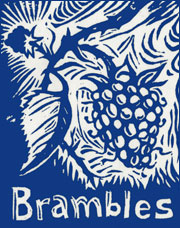
Brambles
Brambles are among the easiest fruit plants to grow in Missouri. They include red, purple and black raspberries and various types of blackberries. Brambles are biennial plants with two types of canes. Primocanes are produced in the current season and floricanes are two-year-old canes that bear flowers and fruit (Figure 2). After planting, a fruit crop is set annually on floricane-producing cultivars under optimal growing conditions.
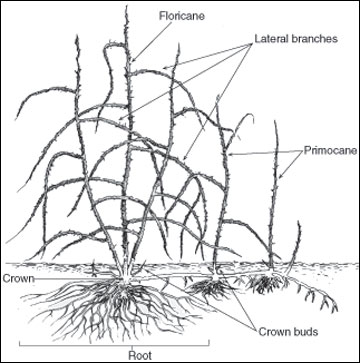 Figure 2. Brambles have two types of canes: primocanes and floricanes. Typically, floricanes produce fruit.
Figure 2. Brambles have two types of canes: primocanes and floricanes. Typically, floricanes produce fruit.
Raspberries
Raspberries can always be identified by their hollow fruit after it is detached from the plant. Optimal growing conditions for raspberries are cool summer temperatures (below 85 degrees F) and a well-drained soil with a pH of 5.5 to 7.0. Raspberry plants have good winter hardiness and are seldom damaged by cold temperatures. When selecting plant material, dormant rooted cuttings are ideal. They can be planted in late March through early April. Tissue-cultured plants can also be planted in early May (after the danger of frost has passed) but require special care when acclimating them to outdoor temperatures and full sunlight. Plants are spaced 2 to 3 feet apart within the row, and rows are spaced 8 to 12 feet apart. One month after planting, apply half a pound (1 cup) of 12-12-12 fertilizer per 10 feet of row (per five plants). Apply half the fertilizer on one side of the row and half on the other side about 4 inches from the base of the plants. The year after planting, apply half a pound of 12-12-12 per 10 feet of row in March. In the third growing season and thereafter, apply 1 pound of 12-12-12 fertilizer per 10 feet of row in March.
There are two types of red raspberries. The summer-fruiting type includes cultivars such as Latham, Boyne and Canby. Titan has large berry size, but it is highly susceptible to root rot when grown in heavy soils. Prune summer-fruiting red raspberries during the dormant season (in winter after plants have defoliated) by removing the floricanes (canes that fruited during the growing season) at the soil surface. Thin remaining canes to three or four canes per square foot (Figure 3).
The second type of red raspberries — fall-fruiting or primocane-fruiting — produces berries on one-year-old canes. Recommended cultivars include Redwing and Heritage. Earlier maturing cultivars, such as Autumn Bliss and Caroline, tend to ripen earlier than Heritage and are not recommended for planting. When raspberries ripen at temperatures above 90 degrees, the fruit is often small, crumbles easily, and has poor flavor. Prune primocane-fruiting raspberries by mowing or using loppers to remove all canes near the soil surface when canes are dormant during late winter (Figure 4).
Purple and black raspberries are planted, fertilized and pruned like summer-fruiting red raspberries (Figure 5). Plants are spaced 3 to 4 feet apart within the row with 8 to 12 feet between rows. One difference between red and the darker-colored types is that new black or purple raspberry plants arise from tips of canes or laterals (side branches) that are in contact with the soil surface. Thus, rows of plants will tend to expand if new plants are not pruned to a 3-foot row width, which makes harvesting more difficult. Because the canes of purple and black raspberries tend to be long, a T-trellis is useful (Figure 6). This trellis has two wires at 24 to 28 inches above the soil surface and 18 inches apart, running parallel to the ground on either side of the row. To prune these types of raspberry plants, remove the tips of primocanes (cutting off 1 to 2 inches of the cane) in June when they reach a height of 30 inches (black raspberries) to 40 (purple raspberries).
This summer tipping forces the plant to branch and increases subsequent fruit set. During the winter, remove old floricanes (canes that fruited during the growing season) at the soil surface. Cut the laterals of the remaining canes back to 12 inches in length. Thin the remaining canes to three to six per plant to increase air circulation and improve light penetration within the plants.
Commonly available varieties of black raspberries include Bristol, Blackhawk and Jewel. Black raspberries are much smaller than other types of raspberries, but their unique flavor makes the time-consuming harvest worthwhile. Brandywine and Royalty are purple raspberries recommended for Missouri. While the berry size of Royalty is large, plants are susceptible to root rot when planted in soils with poor drainage.
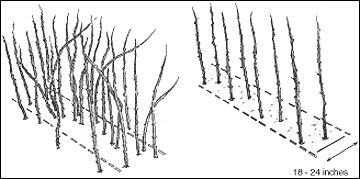 Figure 3. Prune summer-fruiting red raspberries in the winter by removing the old floricanes and thinning the remaining canes.
Figure 3. Prune summer-fruiting red raspberries in the winter by removing the old floricanes and thinning the remaining canes.
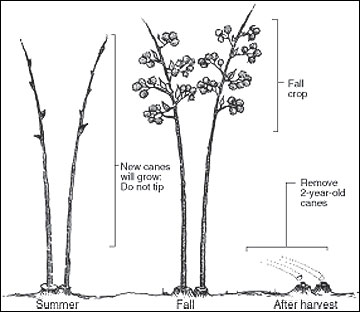 Figure 4. Prune fall-fruiting raspberries in the winter by removing all canes at the soil surface.
Figure 4. Prune fall-fruiting raspberries in the winter by removing all canes at the soil surface.
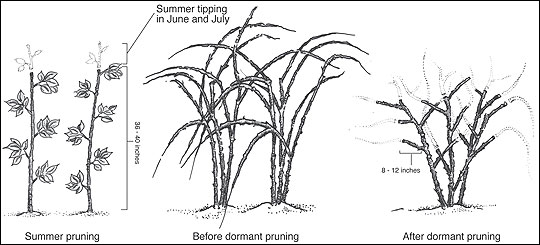
Figure 5. Prune purple and black raspberries by removing primocane tips in the summer and thinning in the winter.
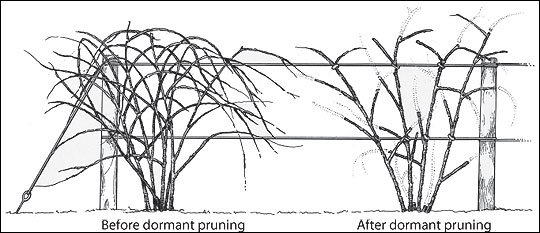
Figure 6. Thornless, semierect blackberries should be trained to a two-wire trellis.
Blackberries
Blackberries are distinguished from raspberries by their large berry size and their solid fruit (the receptacle or torus remains inside the fruit when it is harvested). Because blackberries have solid berries, they are less fragile than raspberries. Blackberries also favor warmer summer temperatures than raspberries. However, blackberries are susceptible to low temperatures, causing canes to die back or lose fruit buds during cold winters. The optimum soil pH range is 5.5 to 7.0. Dormant canes are planted from March 20 to April 15, or tissue-cultured plants can be acclimated to the site and planted after May 10. Plants are spaced 3 feet apart within the row, with 8 to 12 feet between rows. One month after planting, apply half a pound of 12-12-12 fertilizer per 10 feet of row. Apply half the fertilizer on one side of the row and half on the other side of the row about 4 inches from the base of the plant. Fertilize just before a rain or irrigate immediately after fertilizing. In subsequent years, apply 1 pound of 12-12-12 fertilizer per 10 feet of row in March.
The two types of summer-fruiting blackberries are the erect-growing type (does not require a trellis) and the semierect type, which requires a trellis to support the canes. The older erect-growing, thorny cultivars include Shawnee, Chickasaw, Choctaw, Kiowa, Illini Hardy and Darrow. Although Illini Hardy is purportedly hardy in northern states, it is not hardy under Missouri conditions without snow cover or other winter protection. Darrow has smaller fruit size than most other varieties, but it is reliably cold hardy and will produce a crop when others do not. Thornless erect-growing cultivars, such as Arapaho, Apache, Natchez, Navaho, Ouachita and Osage are generally favored over thorny cultivars because the fruit is easier to pick. Blackberries should be pruned in much the same way as described for purple and black raspberries (Figure 5). For all erect-growing types, primocanes are summer tipped (remove 1-2 inches of the cane) when they reach a height of 36 to 40 inches. Summer tipping forces the plant to branch and increases the amount of fruit set on the laterals. During the winter, remove old floricanes (canes that fruited during the growing season) at the soil surface. Cut the laterals of the remaining canes back to 12 to 18 inches in length. Thin the remaining canes to six per square foot to increase air circulation and improve light penetration within the plants.
The second type of summer-fruiting blackberries is the thornless semierect type, which must be trellised. For these blackberries, a two-wire trellis is recommended, one wire placed at 3 feet and another wire at 6 feet above the soil surface (Figure 6). During the summer, primocanes are tipped just above the top wire. In the dormant season, the lateral canes are shortened to 12 to 18 inches. Some of the semierect-growing cultivars include Chester, Hull and Triple Crown. However, these cultivars are susceptible to low-temperature injury during the winter and may not bear fruit every year.
Prime-Jan, Prime-Jim, Prime-Ark 45, Prime-Ark Freedom and Prime-Ark Traveler are primocane-fruiting blackberries. They can produce one crop in the fall on primocanes and then a summer crop the following season on overwintered floricanes. However, when grown in this manner, the summer crop tends to produce few berries. Alternatively, these cultivars can be grown to produce only a fall crop, if the fruiting canes are removed at the soil surface during the subsequent dormant season (similar to primocane-fruiting raspberries). Unfortunately, these cultivars do not set fruit when summer temperatures exceed 90 degrees F for a week or more. Thus, primocane-fruiting blackberries are better adapted to climates with cooler summer temperatures.
Limiting factors
While bramble plants are relatively easy to grow, several factors limit production of high-quality berries in Missouri. Summer temperatures are generally too hot for the harvest of large, high-quality raspberries. Also, raspberries do not tolerate wet soils and several cultivars are susceptible to Phytophthora root rot. Raspberry fruit is highly perishable and should be harvested in the cool hours of the morning and immediately placed in refrigeration. Even when cooled immediately, raspberries will last only two to three days in cold storage before they deteriorate. For blackberries, winter injury can cause cane dieback and fruit bud damage. Blackberries are susceptible to anthracnose, which is easily controlled with lime sulfur before newly emerging leaves are one-fourth inch long. Raspberries may exhibit symptoms of leaf spot when temperatures are warm with high humidity or rainfall. The most common insect pest is the red-necked cane borer, which can be controlled by removing canes.
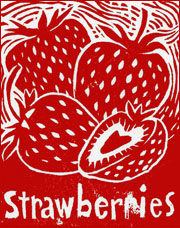
Strawberries
Many strawberries are grown as a perennial plant. The growing point of the plant is inside the crown. New leaves, flowers, runners, roots and branch crowns emerge from the original crown of the mother plant (Figure 7). Runners or stolons grow during the summer, when periods of daylight are longest. At the second node from the crown, new daughter plants are produced. Branch crowns are also formed from buds on the main crown of the mother plant. These crowns do not form their own roots, but produce leaves and flowers independent of the main crown. As branch crowns are formed, the main crown becomes crowded, inefficient and unproductive.
As with brambles, there are summer-fruiting types of strawberry cultivars. For summer-fruiting types, fruit buds form under short-day, cool conditions less than 59 degrees F. Recommended strawberry cultivars for Missouri include Annapolis and Earliglow for early-maturing fruit and Redchief, Honeoye, Surecrop, Delmarvel, Mesabi and Jewel for midseason fruiting. Late-maturing cultivars include Lateglow and Allstar. Strawberries favor a soil that contains a good supply of organic matter with a pH of 6.0 to 7.0.
Plants may be grown in solid beds, strawberry jars, or many other containers or configurations. Most summer-fruiting strawberries are grown in a matted row to facilitate harvest. In the matted row system, space plants 18 inches within the row and 48 inches between rows in late March or early April (Figure 8). Before planting, incorporate 1 pound of 5-10-5 or 8-24-8 fertilizer per 100 square feet into the upper 3 to 4 inches of soil. If you fail to do this, you can prepare a starter fertilizer of 2 tablespoons of 12-12-12 fertilizer per gallon of water and apply about one cup of this solution per plant. If there is no rain within a week of this application, then irrigate. During this first growing season, remove blossoms to promote runner development and control weeds. Train runners to the outside of the row, rather than toward the row middles. Generally, the best fruit is harvested from the outer 4 inches of the rows where there tends to be better light interception. Irrigate during dry periods (1 inch per week) and apply straw mulch (2 to 4 inches) to protect against crown injury. Apply the mulch in the fall when temperatures have dipped to 20 degrees F for a few days (usually about Dec. 1). Alternatively, plants can be protected from low temperatures using a row cover made of nonwoven polypropylene material.
During the second, third and fourth year of production, the management of plants is similar. In early spring (before bloom), rake most of the straw mulch off the plants into the area between rows, but leave a light layer to help control weeds. Harvest fruit in early summer and renovate planting immediately after harvest. To renovate the plants, mow off foliage to remove diseased plant tissue and improve light penetration (take care not to damage crown). Narrow the row using a tiller, sharp hoe or shovel to maintain an 8- to 12-inch-wide row. Next, thin plants to five to seven per square foot. Fertilize with 2-1/2 pounds ammonium nitrate (34-0-0) per 100 feet of row and irrigate to incorporate the fertilizer. Also, irrigate from Aug. 1 to Nov. 1 when floral buds are being initiated. Do not apply 2,4-D to control broad-leaved weeds from Aug. 1 to Nov. 1 because the herbicide will adversely affect floral bud initiation. Remove plants after they have fruited the fourth year to maintain productivity. Purchase new disease-free plants and move new plants to a new site, if possible.
Other types of strawberry plants include the everbearing cultivars such as Ozark Beauty, Ogallala and Fort Laramie. These plants generally produce a large early summer crop and a small fall crop. Plants can be fertilized after the summer crop and thinned to permit more light interception in the bed before plants begin to grow in the spring. A third type of strawberry plants is the day-neutral cultivars, including Tribute and Tristar. These plants are insensitive to day length but will not initiate flowers buds at temperatures above 85 degrees F. Therefore, plants grown in Missouri generally produce only two small crops in early summer and in the fall when the heat of summer has passed. Day-neutral cultivars are generally grown as annuals or can fruit for two years. When plants are kept for three years, management becomes difficult because the large number of crowns increases susceptibility to diseases. Day-neutral types of strawberries can also be grown in high tunnels to produce early-season fruit.
Limiting factors
Some of the limitations of growing strawberries in Missouri include the difficulty of weed control in both new and established beds. There are few herbicides currently labeled for use in strawberries, and some of the preemergence herbicides can injure young plants or developing runners. Periods of high humidity and rainfall result in many diseases such as leaf spot, leaf scorch, gray mold, leather rot, verticillium wilt and red stele. Various cultivars have resistance to some diseases.
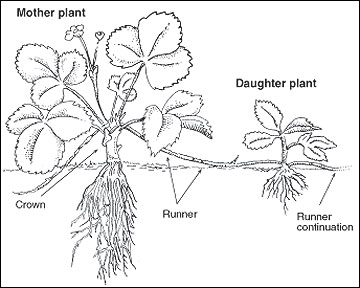 Figure 7. Most strawberry plants are perennials that spread by runners from a mother plant.
Figure 7. Most strawberry plants are perennials that spread by runners from a mother plant.
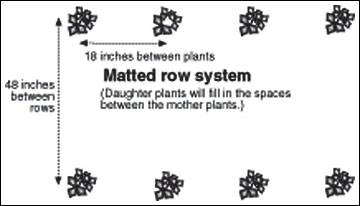 Figure 8. Growing summer-fruiting strawberries in matted rows makes them easier to harvest.
Figure 8. Growing summer-fruiting strawberries in matted rows makes them easier to harvest.
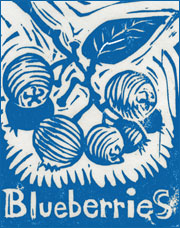
Blueberries
Blueberries are perennial plants that can grow more than 8 feet tall. In spite of their capacity to produce abundant growth above ground, these plants always have a small root system when grown in Missouri soils. Although there are many types and species of blueberries grown in the United States (lowbush, southern high-bush, half-highs and rabbiteyes), the northern highbush types often perform the best under Missouri’s climatic conditions. Blueberries require a soil that contains a good supply of organic matter (greater than 3 percent) with a pH of 4.8 to 5.2, and less than 2,000 pounds of calcium per acre (obtained from soil test results). Blueberry plants require good soil drainage but also an adequate supply of irrigation water during periods of drought. Because few soils in Missouri meet these requirements, the soil at the planting site is usually amended before planting. In the fall before planting, obtain a soil sample for testing. Generally the soil test report will include recommendations for soil improvement. If the soil pH is too high, incorporate wettable (elemental) sulfur as recommended before the soil freezes. To lower the pH one unit (for example, from 6.0 to 5.0), apply the following amount of wettable sulfur to 100 square feet: 1/2 to 3/4 pound for coarse sandy soils; 1 to 1-1/4 pounds for medium-textured soils (silt loams); or 1-1/2 to 2 pounds for fine-textured soils (clay types). At planting, incorporate 1 gallon of peat moss per plant into the planting hole or furrow to a 6-inch depth. Early-maturing cultivars include Collins and Duke. Recommended cultivars that mature in midseason are Bluecrop, Brigitta Blue, Blueray, Legacy and Reka. Nelson produces fruit late in the harvest season.
Dormant rooted cuttings of blueberries are planted in late March or early April at a spacing of 4 feet within the row and 8 to 12 feet between rows. Blueberries set more fruit when cross-pollinated by another blueberry variety that blooms at the same time. About one month after planting, apply 0.1 pound of 12-12-12 fertilizer per plant in a circular pattern about 6 inches from the base of the plant. After fertilizing, mulch plants with 4 to 6 inches of straw or composted bark mulch. In the second year after planting, apply 0.2 pound of 12-12-12 fertilizer per plant at the early bloom stage. Following this treatment, make two more applications of ammonium sulfate spaced six weeks apart at a rate of 0.2 pound of product per plant. In the third and subsequent years after planting, apply 0.3 pound of 12-12-12 fertilizer per plant at the early bloom stage. Then, make two more applications of ammonium sulfate spaced six weeks apart at a rate of 0.2 pound per plant. These are general fertilizer recommendations suitable for most sites. Once the plants begin fruiting, the amount of fertilizer applied should be based on foliar test results.
During the year of planting and the following growing season, remove blossoms to prevent fruiting and to develop a strong vegetative plant. Allow plants to bear a light crop of fruit in the third year. Wait a few days after the fruit turns completely blue before harvesting. The back side of the fruit should be uniformly blue, and berries should separate easily from the plant, without tearing the skin. Some cultivars, such as Bluecrop and Blueray, often set an extremely heavy crop of fruit, with little vegetative growth. If this occurs, strip off some blossoms or small fruit early in the season to achieve a good balance of reproductive and vegetative growth and to ensure adequate fruiting the next growing season.
Blueberry plants generally require about 2 inches of water per week because of their limited root system. Plants suddenly subjected to drought stress will first exhibit necrosis (browning) at leaf margins, and young plants can die after only a few days of extreme heat without water. However, take care not to overirrigate as plants do not tolerate waterlogged soils.
Begin pruning of blueberry plants in the third year after planting. Start by pruning out dead or diseased canes. Remove only a few canes each year at the soil surface to thin out the plants, improve light penetration within the plants and enhance air circulation within the plant canopy (Figure 9). When possible, maintain an equal number of one-, two-, three- and four-year-old canes. Each year new canes should grow from the base of the plant.
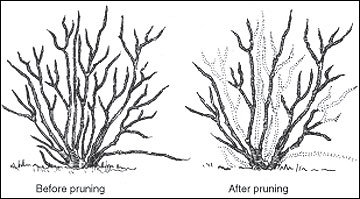 Figure 9. Prune blueberry plants by removing a few canes each year to improve light penetration and air circulation.
Figure 9. Prune blueberry plants by removing a few canes each year to improve light penetration and air circulation.
Limiting factors
One of the main limitations of growing blueberries in Missouri is maintaining the soil pH between 4.8 and 5.2. If the pH is over 5.2, use sulfur and ammonium sulfate fertilizers to lower pH to an optimal level. If new foliage appears chlorotic (yellow), this usually indicates that iron is unavailable to the plant because soil pH is above 5.2. Although a foliar application of iron chelate can be applied to green-up the plant temporarily, the best long-term solution to the problem is to adjust the pH to the optimal level by using sulfur or ammonium sulfate. Another limitation to growing blueberries is the control of bird feeding on the fruit. Most birds are temporarily controlled by the use of Mylar tape, aluminum foil or bull’s-eye balloons. Netting can be purchased and used to enclose the plants during harvest to prevent fruit loss. Diseases such as phomopsis stem blight, phytopthora root rot or stem blight can also be problematic.
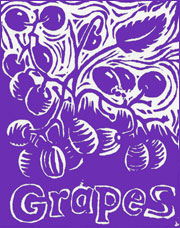
Grapes
Grapevines produce a tendril, leaf or flower cluster at each node (Figure 10 inset). Buds are compound structures that contain primary, secondary and sometimes tertiary flowers. The presence of flowers in secondary buds is important because they can produce a replacement crop (although a smaller one) of berries when flowers in primary buds are killed by frost. Several species of grapes are commonly grown in Missouri. American grapes (Vitis labrusca), such as the cultivars Concord, Delaware, Catawba, Niagra and Sunbelt, have seeds. Seedless or nearly seedless cultivars used as fresh dessert grapes include Himrod, Reliance and Mars. All of these cultivars are adapted to Missouri growing conditions with a soil pH of 5.5 to 6.5. These cultivars have good winter hardiness and are seldom damaged by cold temperatures.
There are many types of grapes grown for wine production. The scientific name for the red Norton grape (also known as Cynthiana) is Vitis aestivalis. Other grapes, known as American hybrid cultivars, are derived from native North American grape species and include cultivars derived from Vitis labrusca, Vitis aestivalis and other Vitis species. Some of these cultivars used for white wine include Chardonel, Marquis, Traminette and Vivant. Most of these cultivars should only be planted at optimum growing sites. Recently a new classification of grapes has been developed for neo-American hybrids, which are derived from a 20th- and 21st-century hybrid produced in North America from a North American Vitis species and V. vinifera. Some of these cultivars used for making wine include Edelweiss, Marquette, St. Croix, St. Vincent, La Crescent, Esprit, Prairie Star, Frontenac and Frontenac Gris. The last types of wine grapes are the French-American hybrids, which are derived from American species and Vitis vinifera, the grape species grown primarily in Europe and California. Some of these cultivars that can be grown in Missouri include Seyval blanc, Vidal blanc, Vignoles, (white) and Chambourcin (red). These cultivars are more susceptible to winter injury than most American grapes.
Most grapes are purchased as dormant, rooted canes, which can be planted in late March or early April. Vines can be trained in many different forms on arbors or on a trellis system as long as the canes are exposed to full sunlight. Most vines are productive when trained and pruned as a single-curtain cordon system, also known as bilateral cordon system (Figure 11). For this training system, place plants 8 feet apart within the row and allow 10 to 12 feet between rows.
Immediately after planting, cut the vine back to one shoot with two buds. Tie a string from base of plant (near the soil surface) to the top of the wire (Figure 11a). About a month later, train the strongest growing shoot up the string and let the other shoot grow along the ground (Figure 11b). When the vine gets to the top of the string (first or second year), pinch off about an inch of the terminal growth to force the vine to branch. The two lateral branches will be trained and tied to the wire in opposite directions, each forming a cordon (Figure 11c). Remove all flower clusters in year two. Generally, during the third growing season, the “curtain” is produced (cane growth from the lateral-growing cordons). Position the growth downward and allow only one cluster of fruit to set during this year (Figure 11d). In the subsequent dormant season (early March), prune the lateral growth on the cordons, leaving a cane or “spur” every 8 to 12 inches. Then cut back each spur, leaving only four buds at the base of the cane (Figure 11e). Remove all other prunings from the planting. In subsequent years, choose new spurs to renew the curtain.
Grapevines require annual fertilization beginning about a month after planting. At this time, apply 3 tablespoons of 12-12-12 fertilizer in a circle (about 6 inches from the base of the plant). Repeat twice at monthly intervals, applying the fertilizer in slightly larger circles each time. For two-year-old or older plants, apply 3/4 pound (1-1/2 cups) of 12-12-12 fertilizer per vine beneath the plant in March or early April as a rule of thumb. However, foliar analysis is recommended to ensure proper nutrition of bearing vines. Irrigation is necessary during vine establishment and during droughty periods. Water is critical in the last two to three weeks before harvest.
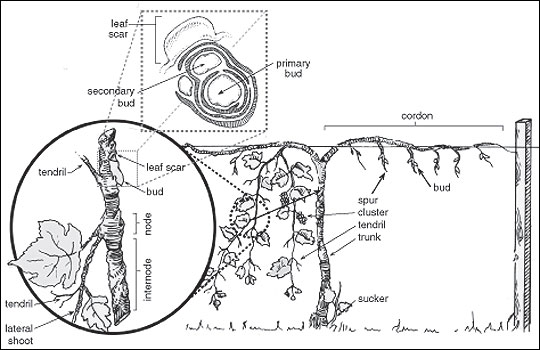
Figure 10. Grapevine terminology.
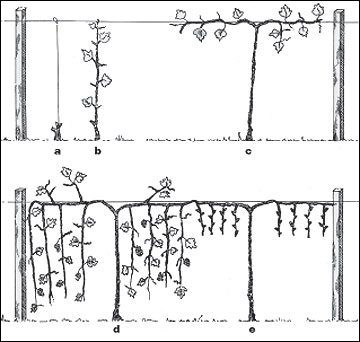 Figure 11. Single-curtain cordon system. Trellising promotes productivity by exposing vines to sunlight.
Figure 11. Single-curtain cordon system. Trellising promotes productivity by exposing vines to sunlight.
Limiting factors
There are several limitations of growing grapes in Missouri. Particularly for French-American hybrid cultivars, low winter temperatures can result in trunk injury and crown gall infections. Spring frosts injure flowers and reduce yield. Other problems include diseases such as black rot, Phomopsis cane and leaf spot, Botrytis bunch rot, anthracnose, and downy and powdery mildew due to humid growing conditions. Insect pests include grape berry moth, grape flea beetle and grape phylloxera. Commercial growers generally spray every 10 to 14 days during growing season to control pests. Deer can cause damage to the vines and birds will often feed on the ripening fruit. A vegetation-free, 3-foot wide band underneath vines is recommended to avoid competition with other plants for nutrients and water.
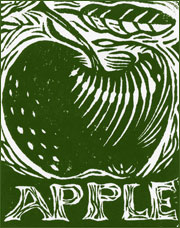
Apples
Commercially available apple trees are produced by grafting or budding a scion cultivar onto a rootstock. While the scion cultivar determines appearance and flavor of the apple, the rootstock controls the size of the mature tree, age when the tree begins bearing fruit, lifespan of the tree, cold hardiness, and tolerance to diseases and insect pests.
Trees on nondwarfing rootstocks are slow coming into bearing ( at least five to seven years after planting) and are large at maturity, requiring ladders for harvest. These trees can be more than 25 feet tall at maturity and live for 50 years or more. Dwarfing rootstocks, with names such as M.9 and M.27, are commonly used to facilitate harvest. Besides producing trees of moderate size, many dwarfing rootstock cultivars are precocious (bear fruit earlier than standard apple trees). Trees on these rootstocks require staking and can be maintained under 10 feet tall. Trees will start producing fruit in the second or third year after planting, but may only have a lifespan of 15 to 20 years.
Semidwarfing rootstocks produce a tree that may be 20 feet or taller on fertile, well-drained soil. M.7 rootstock (75 percent size of a seedling tree) and MM.111 (85 percent of a seedling tree) perform well on most Missouri sites (Figure 12). M.26 rootstock is not recommended because it is extremely susceptible to fire blight. Even though these trees may be advertised as freestanding, use an 8-foot stake to support trees on dwarfing rootstock at planting and a 5-foot stake to support trees on M.7 rootstock). Stakes may be removed from M.7 trees when they are self-supporting after seven years. Trees generally will not bear a full crop of fruit until five or more years after planting. These trees will usually have a lifespan of more than 25 years.
Many apple cultivars are suitable for use in Missouri. To reduce the incidence of disease infections, plant a disease-resistant cultivar such as Liberty or Enterprise. Other disease-resistant varieties include Jonafree, Redfree and Goldrush, but they may not be resistant to all disease organisms. Unfortunately, insect-resistant cultivars are not available.
Apple trees will tolerate a variety of soils. Always obtain a soil test before planting. Some nutrients, such as phosphorus, are difficult to incorporate into the soil after the tree has been planted. A pH in the range of 6.0 to 6.5 is desirable. To avoid disease problems, do not replant an apple tree in a spot where one was previously planted. Plant dwarf trees at least 8 feet apart; semidwarf trees at least 15 to 20 feet apart, and seedling trees 25 feet apart in late March or early April.
Apple trees are generally trained to a central leader structure that has a narrow pyramidal form (Figure 13). An ideal bare-rooted tree will have four scaffold limbs spaced evenly around the trunk at about 26 to 30 inches from the soil surface (Figure 14a). However, when trees are purchased from mail-order companies, scaffold branches may be damaged during shipping. If so, training and pruning techniques should be used to develop the new tree structure. If the tree has few or no branches off the main trunk, cut the leader back to 30 inches and remove all lateral limbs back to the main trunk (Figure 14b). During this first growing season, the goal is to select four good scaffold branches that are evenly spaced around the trunk of the tree at about 26 to 30 inches from the soil surface.
In May, June or early July, all lateral branches that have branch angles less than 60 degrees with the central leader should be spread to this angle from the trunk with clothespins or clothespins attached to weights to strengthen the tree and to encourage earlier fruiting (Figure 14c). Weights and clothespins can be removed after a month or left in the tree until the dormant season. To prevent breakage, tie the terminal portion of the leader to a stake if the tree is on a dwarfing or M.7 rootstock. In the dormant season, do not prune the central leader. Remove any upright-growing lateral branches. Avoid cutting into one-year-old growth on lateral branches or scaffold limbs (that is, heading cuts) as this promotes excessive vegetative growth.
During the second growing season, maintain the narrow pyramidal shape of the tree by removing any vigorous shoots that are competing with the central leader in March (Figure 14d). Do not cut into one-year-old wood to avoid creating multiple branches at the tips of lateral branches. Many cultivars grown on a dwarfing rootstock will bloom and set fruit on two-year-old or older wood (spurs). To prevent limb breakage and to maintain vegetative growth, remove any fruit that sets this season when it is smaller the diameter of a dime. From May through early July, use clothespins or weights on young limbs that have a branch angle of less than 60 degrees. Wood spreaders can be used to spread older branches. Tie the terminal portion of the leader to the stake. Sucker growth (branches growing vertically) can be removed during the fall or dormant season.
In March of the third growing season, remove vigorous shoots that compete with the leader and prune to maintain the narrow pyramidal shape of the tree (Figure 14e). Continue to spread the branches near the top of the tree. Thin the fruit to one fruit per cluster to prevent limb breakage. Do not cut into one-year-old growth as this promotes branching at the tips of the branches. Always cut back into two-year-old or older wood to a less vigorous lateral branch. To limit the height of the tree, cut back the central leader to a less vigorous branch, which will form a new leader (Figure 14f).
Figure 12. Dwarfing and semidwarfing rootstocks determine the height of mature apple trees.
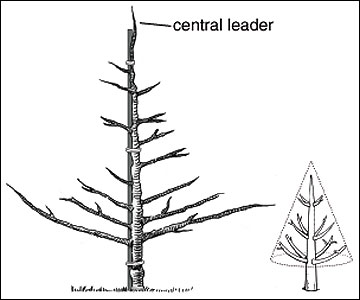 Figure 13. Central leader system.
Figure 13. Central leader system.
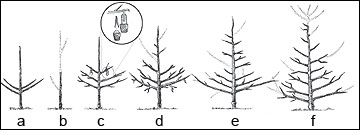
Figure 14. Training a tree to the central leader system begins at planting.
- An ideal tree for planting with four properly spaced scaffold branches.
- If tree lacks four good scaffold branches, cutback to 30 inches, removing lateral branches.
- Limbs are spread in late June or early July of the first growing season to a 60 degree angle from the trunk. Clothespins attached to weights can be used to spread limbs
- In March of the second growing season, remove vigorous shoots that complete with the central leader.
- In March of the third growing season prune lower branches to maintain the narrow pyramid form and any shoots growing vertically.
- To limit the height of the tree, the central leader can be cut back to a less vigorous lateral branch to form a new leader.
Annual maintenance
After the third growing season it is important to maintain trees in a narrow pyramidal form. In the upper portion of the tree, branches that compete with the leader are removed and older branches are renewed. These older branches are cut near the central trunk into two-year-old or older wood leaving a 1-inch stub. Vegetative buds at the base of stub cuts will produce a new branch and ensure that new fruiting wood is present near the top of the tree.
Mature trees that have not been carefully maintained will have a round shape or one that is wider at the top of the tree than the bottom. The process of restoring pyramidal form may take several years because no more than one-third of the branches should be removed in a growing season (Figure 15). To restore a narrow pyramidal form, make major cuts near the trunk in the top one-third of the tree and stub cuts to remove entire branches. Remove upright sucker growth and shoots growing back toward the center of the tree. Branches that lie directly over another and shade the lower limb should be eliminated. Also, remove branches that are growing at narrow angles (less than 45 degrees).
It is important to thin fruit annually to avoid irregular cropping. Thin to one fruit per cluster when fruit are small to prevent infection from diseases and insect feeding where two fruits hang together. Thinning also increases fruit size and ensures fruit set the following season. If fruit are not thinned, the crop will be greatly reduced the following year.
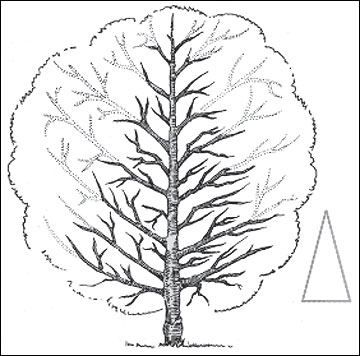 Figure 15. Maintaining the central leader system. A mature tree that does not have a narrow pyramidal form should be cut back to the desired tree form over a period of years.
Figure 15. Maintaining the central leader system. A mature tree that does not have a narrow pyramidal form should be cut back to the desired tree form over a period of years.
Applying fertilizer
Apple trees should have about 12 to 18 inches of new growth each year when they are young (one to six years old) and 6 to 12 inches of growth thereafter. Adjust fertilizer rates to maintain shoot growth in these recommended ranges. Trees require about 1 inch of water per week. As a general guide, apply a quarter pound of actual nitrogen (about a half cup of 12-12-12 fertilizer) in a circular pattern about 6 inches from the tree trunk one month after spring planting. In subsequent years, gradually increase the amount of fertilizer applied to produce the optimal amount of new shoot growth. Never apply more than 2 pounds of actual nitrogen per year. On bearing trees, foliar analysis can be used to obtain optimal fertilizer recommendations for a specific site.
Limiting factors
A frequent question concerns the failure of trees to bear fruit. First, if the rootstock is not precocious, the tree may be too young to set fruit. A second reason for the lack of fruit may be that low temperatures killed the fruit buds or blossoms. Alternatively, there may have been a pollination failure. Always check to see if there is another apple or crabapple tree nearby that is blooming at the same time. Pollination failure may be caused by a lack of bees or by windy, rainy conditions during the bloom period. If there are many dandelion flowers present while the apple trees are in bloom, bees may visit the weeds rather than the apple blossoms. Also check the cropping history. If there was a heavy crop produced last year, especially without thinning, there will be little crop in the subsequent season.
Pest problems frequently limit growing apples in Missouri. Diseases, such as apple scab, powdery mildew, cedar apple rust, fire blight, white rot, sooty blotch and flyspeck can be problematic. Also, codling moth, aphids, mites, scale, leaf rollers, leaf miners and borers are common insect pests. Some of these pests are difficult to manage using organic cultural methods. Thus, if blemish-free fruit is desired, trees will likely require spraying every 10 to 14 days during the growing season.

Pears
Pear trees are not widely grown in Missouri because of their susceptibility to fire blight. Many of the favorite European pear cultivars (Bartlett, Red Bartlett, Comice, Anjou) and Asian pears (Housi, Shinseiki) are especially susceptible to fire blight and therefore are not recommended for planting in Missouri. Common European-type cultivars that are somewhat resistant to fire blight include Seckel, Moonglow, Starking Delicious, Kieffer and Harrow Delight. Shinko and Korean Giant are two Asian pear cultivars that have shown some resistance to this disease. Pear cultivars are often grafted onto an Old Home x Farmingdale rootstock. These trees are very large at maturity and should be planted at least 18 feet apart.
Pear trees can be trained to a central leader system (see Figure 13), but branches are more difficult to spread than those of apple trees because of their stiff, upright growth habit.
To fertilize bare-root pear trees, apply a quarter pound of actual nitrogen (about a half cup of 12-12-12) one month after spring planting (April 1 to 15) in a circular pattern about 6 inches from the tree trunk. In subsequent years, fertilize trees as described in the apple section. For bearing trees, apply no more than 1 pound of actual nitrogen annually in March.
Soon after fruit set, thinning may be needed to prevent limb breakage. Early-season fruit thinning will result in larger remaining fruit at harvest. Pick pears before they are fully ripe (when the color changes from green to a yellowish green and the fruit separates from the branch with an upward twist). After refrigeration, allow the fruit to ripen at room temperature for about four days before eating.
Limiting factors
Fire blight is the primary limitation of growing pears in Missouri. This disease infects and kills blossoms, fruit and limbs of trees. It can also kill young trees rapidly. Many of the same insects that infest apple trees also affect pear trees. While European-type pear trees are quite winter hardy, Asian trees are more susceptible to cold temperatures. Bud loss may occur in late winter or spring. Also, the fruit surface of Asian pears is easily punctured by hail. All pears are susceptible to fruit bruising.
Stone fruit
Peach, nectarine, apricot, plum and cherry trees are categorized as stone fruit, because they each contain a single, large seed. All stone fruit trees are propagated by budding, with a scion cultivar grafted onto a rootstock. While all stone fruit can be grown in Missouri, low winter temperatures and spring frosts can cause crop loss. Peaches are the most commonly grown stone fruit in Missouri, although low winter temperatures shorten the life of these trees to about 10 years.
Peaches and nectarines
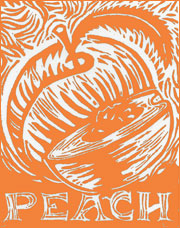
Peaches and nectarines have similar tree and fruit characteristics, except for the lack of “fuzz” on the surface of nectarines. There are many peach cultivars, including Reliance, Contender, Encore and Cresthaven. Redhaven is one of the hardier cultivars recommended for Missouri. These cultivars are often budded onto Lovell rootstock, although Halford, Nemaguard or Guardian may also be used. As yet, there is not a good dwarfing peach rootstock on the market. Some commercially available nectarine cultivars include RedGold, Crimson Snow, Crimson Gold, SunGlo, Juneglo and Ovation.
Peach and nectarine trees require well-drained soil and an adequate supply of rainfall or irrigation water. A soil pH in the range of 6.0 to 6.5 is desirable. To avoid disease and nematode problems, do not replant a peach tree in a spot where a stone fruit was previously planted. Dormant, bare-root trees are planted at least 15 feet apart in late March or early April. Trees are generally trained to an open center structure (Figure 16). The ideal tree for planting has three to four scaffold limbs spaced evenly around the trunk at about 28 inches from the soil surface. If the tree lacks this limb placement (Figure 17a), cut the leader back to 30 inches and remove all lateral branches back to the main trunk immediately after the tree is planted (Figure 17b). During the first growing season, select three or four good scaffold branches (with wide crotch angles) that are evenly spaced around the trunk of the tree at 26 to 30 inches from the soil surface (Figure 17c). Remove any other branches that grow below this height during the growing season. Also, remove all blossoms from limbs to develop a strong tree structure during the first and second growing season. In the dormant season after planting, remove about one-third of the terminal growth from the three or four scaffold branches (Figure 17d). Always cut back to an outside bud to direct the growth outward. Remove all other branches. In each of the subsequent dormant seasons, remove about one-third of the terminal growth on the scaffold branches (Figure 17e). Remove any shoots growing toward the center of the tree and any diseased or dead wood. In the third growing season, allow the tree to bear a light crop of fruit. At each node, there are two floral buds that can each produce a fruit. If all the buds are allowed to set a fruit, limb breakage will occur. Thus, developing fruit should be removed early in the growing season, leaving fruit spaced about 10 to 12 inches apart. Thinning the fruit will also help maintain the optimal balance of reproductive and vegetative growth. When trees grow too tall for easy harvesting (about 12 feet), they can be topped during the dormant period.
In general, trees should have 18 to 24 inches of new growth each year when they are young (one to six years old) and 12 to 16 inches of growth thereafter. Adjust fertilizer rates to maintain shoot growth in these recommended ranges. As a general guide, apply a quarter pound of actual nitrogen (about a half cup of 12-12-12 fertilizer) one month after spring planting (March 20 to April 15) in a circular pattern about 6 inches from the tree trunk. In subsequent years, gradually increase the amount of fertilizer applied to produce the optimal amount of new shoot growth. Most mature peach trees require 1 to 2 pounds of actual nitrogen per year applied in March. To ensure proper nutrition, foliar testing can be used on trees bearing fruit. While trees require irrigation during droughty periods, the period of final swell (the last few weeks before harvest) is a critical time for irrigation. If water is limited during this time, fruit size will be reduced.
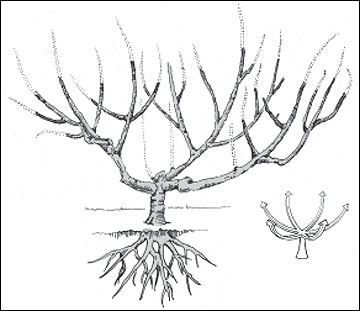 Figure 16. Open center structure.
Figure 16. Open center structure.
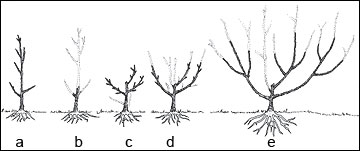
Figure 17. An open center structure is commonly used for stone fruit trees.
- Often trees do not have three or four branches that are evenly spaced around the trunk at 26 to 30 inches above the soil surface when they arrive from the nursery.
- If good scaffold branches are absent, cut the leader back to 30 inches above the soil surface and remove remaining lateral branches.
- Select 3 or 4 that are evenly spaced around the trunk during the first growing season.
- In March of the second growing season, cut back scaffold branches and remove suckers growing vertically.
- In March of the third growing season, cut back scaffold branches. Remove suckers growing vertically and shoots growing toward the center of the tree.
Limiting factors
Limitations to growing peaches and nectarines in Missouri include their susceptibility to low winter temperatures and spring frosts. In southeast Missouri, normal production is three full crops and one partial crop in every four years. In the Ozark region, typically one full and two partial crops are produced in every four years. In northern Missouri, one full crop and one partial crop are generally produced in every four years. Unfortunately, blemish-free fruit are difficult to produce organically. Commercial producers spray trees every 10 to 14 days during the growing season. Some of the major diseases of peaches and nectarines include brown rot, peach leaf curl, bacterial spot and canker. Plum curculio, oriental fruit moth, aphids, mites, Japanese beetles and borers are often problematic.
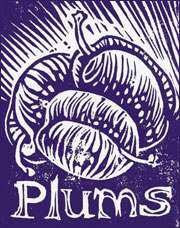
Plums
The two main kinds of plums are the European (blue or prune types) and the Japanese cultivars (often red, yellow or green), which tend to be less hardy than the blue plums. Some of the common European plum cultivars are Earliblue, Bluefre, Stanley and Damson. These types of plums generally don’t require two varieties to be planted for cross-pollination, but there are some exceptions. European plums will not pollinate Japanese plums. Some of the Japanese cultivars include Santa Rosa, Ozark Premier and Redheart, but these cultivars will not routinely bear fruit in many parts of Missouri. These trees must be cross-pollinated. Often nursery catalogs will list a good pollinizer for a particular cultivar. Plumcots are derived from the hybridization of plum and apricot and require cross pollination (often a Japanese plum). For plum trees, Myrobalan is the most commonly used rootstock.
Plums require well-drained soil, with an optimum pH in the range of 6.0 to 6.5 and an adequate supply of rainfall or irrigation water. Plant dormant, bare-root trees at least 15 feet apart in late March or early April. Trees can be trained to either a central leader (see Figure 13) or an open center (see Figure 16). However, because plum limbs normally have wide branch angles, it is not usually necessary to spread limbs. Generally, plum trees require little pruning.
Trees should have 10 to 20 inches of new growth each year when they are young (one to six years old) and 8 to 12 inches of growth thereafter. Adjust fertilizer rates to maintain shoot growth in these recommended ranges. As a general guide, apply a quarter pound of actual nitrogen (a half cup of 12-12-12 fertilizer) one month after spring planting (April 1 to 15) in a circular pattern about 6 inches from the tree trunk. In subsequent years, gradually increase the amount of fertilizer applied to produce the optimal amount of new shoot growth. Most mature trees require 1 pound of actual nitrogen per year applied in March. Most plum trees will not bear fruit until three to five years after planting. In some years, trees will require fruit thinning to prevent an excessive crop that season followed by a small crop the following season. Thinning also prevents limb breakage and helps maintain the structure of the tree. Fruit should be harvested and cooled immediately to prolong the life of the fruit. Limiting factors
The main limitations of growing plums in Missouri are their susceptibility to low winter temperatures, spring frosts and diseases. Black knot, plum pockets and brown rot are some of the diseases that occur routinely. Many of the pests that infest peaches also damage plums.
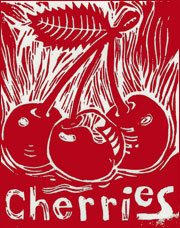
Cherries
Two types of cherries (tart and sweet) can be grown in Missouri. Tart cherry cultivars include Montmorency, Northstar, Balaton and Surecrop. These cultivars are commonly budded onto Mahaleb rootstock. Tart cherry trees generally do not require two varieties to be planted for cross-pollination. Sweet cherries are less winter hardy than the tart types, so crop loss may occur in central and northern Missouri. Bing, Emperor Francis, Royalton, Stella, Lapins and Royal Ann are common sweet cherry cultivars. All sweet cherries except Stella, Lapins and Starkrimson require cross-pollination. Nursery catalogs often list specific cultivars that are suitable pollinizers. Sweet cherry trees are commonly budded onto Mazzard rootstock. Other rootstocks include Mahaleb, Colt and Stockton Morello.
All cherry trees require a well-drained soil. Cherry trees do not tolerate “wet feet.” A soil pH in the range of 6.0 to 6.5 is desirable. For trees on nondwarfing (that is, standard) rootstocks, space dormant bare-rooted plants at least 18 feet apart from March 20 through April 15. Trees can be trained to a central leader (see Figure 13) or an open center structure (see Figure 16) as described above. Properly fertilized trees will have the same amount of new growth each year as described for plums. Similarly, fertilizer guidelines are also similar to those for plums. Most mature trees require 1 pound of actual nitrogen per year applied in March. Generally, cherry trees will not bear fruit until three to five years after planting.
Limiting factors
The major limitations of growing cherries in Missouri are that trees are intolerant of waterlogged or flooded soils and they are susceptible to low winter temperatures and spring frosts. Cherries are also very susceptible to cracking when rainfall occurs just before harvest. Common diseases include brown rot, cherry leaf spot and black knot. Birds are also problematic. While netting can be used, it is often difficult to cover large trees.
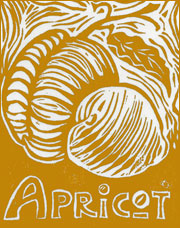
Apricots
Apricots are the most difficult stone fruit to grow in Missouri because of their earliness to bloom. Typically, apricot trees bloom three weeks before peaches (about March 25 in central Missouri) so the blossoms are often killed by spring frosts. In central Missouri, only two crops of apricots are typically produced in every seven years. Some common cultivars include Wilson, Goldcot and Harglow. Cultivars are commonly budded onto an apricot seedling rootstock such as Manchurian hardy apricot, on Lovell or Nemaguard peach seedlings, or on Myrobalan or Marianna 2624 plum seedlings. Apriums are hybrids of apricot and plum. Aprium cultivars are often pollinated by another apricot tree.
Apricot and cherry rees have similar site requirements. Bare-root, dormant trees are planted at least 18 feet apart in late March or early April. Trees should be trained to an open center (see Figure 16). Recommended growth rates and fertilizer application rates for apricot trees are similar to those for plums. Most trees will not bear fruit until three to five years after planting. At harvest, fruit should be handled with care to avoid bruising. Immediate refrigeration after harvest will prolong the life of the fruit.
Limiting factors
The main limitation of growing apricots in Missouri is irregular cropping due to spring frost damage. Apricot trees may be better used as an ornamental tree because of its glossy foliage and white bloom. In fact, trees may set fruit buds for more than 50 years. Phytophthora root rot, brown rot and bacterial spot can be problematic. Insect pests of apricot trees are similar to those of peach.
 Michele Warmund
Michele Warmund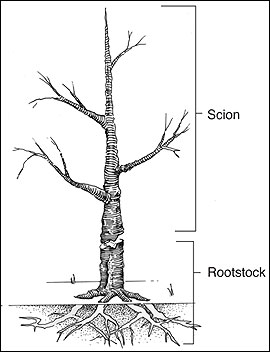 Apple trees are grafted or budded at the nursery by joining the scion, or top portion, of one cultivar to the rooted stock of another tree. The scion and the rootstock separately determine the characteristics of the mature tree and the fruit. After planting and watering, the graft union should be 2 inches above the soil surface. dwarfing rootstocks semidwarfing rootstocks
Apple trees are grafted or budded at the nursery by joining the scion, or top portion, of one cultivar to the rooted stock of another tree. The scion and the rootstock separately determine the characteristics of the mature tree and the fruit. After planting and watering, the graft union should be 2 inches above the soil surface. dwarfing rootstocks semidwarfing rootstocks